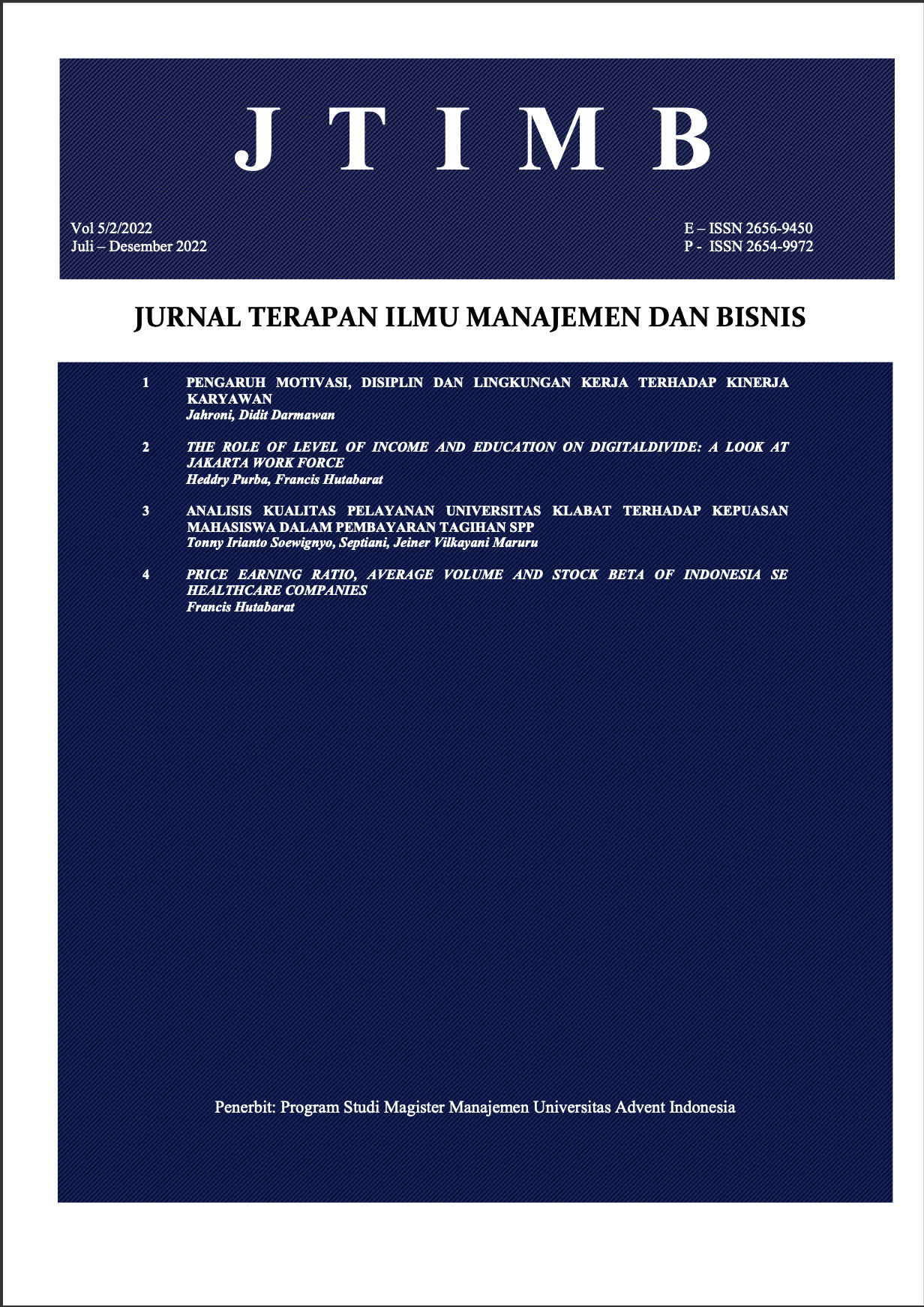The ROLE OF LEVEL OF INCOME AND EDUCATION ON DIGITAL DIVIDE: A LOOK AT JAKARTA WORK FORCE
Kata Kunci:
Education, Level of income, digital divideAbstrak
Communication technologies is important in supporting economic, human, and social growth. However, it common knowledge that communication technologies are differ between countries. And the digital difference inside nations can be as high as that between countries. ). The objectives of this study are to assess the Indonesia home digital divide for its Jakarta workforce and to examine the demographic features, specifically: education and level of income as factors influencing digital divide. The study is descriptive and survey questionnaire is employed. Indonesian workers in Jakarta and graduates of the Indonesia Adventist University in Bandung are the study's subjects. There are 239 sample of the study. Frequencies, correlation, significant test, and regression test were used in the analysis. The study found that, simultenously, there is a significant relationship between education and level of income on digital divide of Jakarta workforce. The study also indicates there is no significant relationship based on t-test between education and digital divide. On the other hand, level of income shows that it has significant result with t-test at 10% level of significant.
Referensi
Alexander, J.A., van Deursen, A.J. and Helsper, E.J. (2015), “The third-level digital divide: who benefits most from being online?”, Communication and Information Technologies Annual, Vol. 10, pp. 29-52.
Anca Elena-Bucea, A., Cruz-Jesus, F., Oliveira, T., & P. S. Coelho. (2020). Assessing the Role of Age, Education, Gender and Income on the Digital Divide: Evidence for the European Union. Information Systems Frontiers. https://doi.org/10.1007/s10796-020-10012-9
Bowie, N.A. (2000), “The digital divide: making knowledge available in a global context”, Schooling for Tomorrow: learning to Bridge the Digital Divide, OECD publishing
Erlindawati, E., & Novianti, R. (2020). Pengaruh Tingkat Pendidikan, Pendapatan, Kesadaran Dan Pelayanan Terhadap Tingkat Motivasi Masyarakat Dalam Membayar Pajak Bumi Dan Bangunan. IQTISHADUNA: Jurnal Ilmiah Ekonomi Kita, 9(1), 65-79.
Gladkova, A. and Ragnedda, M. (2020), “Exploring digital inequalities in Russia: an interregional comparative analysis”, Online Information Review, Vol. 44 No. 4, pp. 767-786
Gunkel, D. J. (2003). Second thoughts: Toward a critique of the digital divide. New Media & Society, 5(4), 499–522. https://doi.org/10. 1177/146144480354003
Helsper, E.J., van Deursen, A.J. and Eynon, R. (2015), Tangible Outcomes of Internet Use. From Digital Skills to Tangible Outcomes Project Report, Oxford Internet Institute, Oxford.
Lutz, C. (2019), “Digital inequalities in the age of artificial intelligence and big data”, Hum Behav and Emerg Tech, Vol. 1, pp. 141-148.
Marín-Raventós, G.; Calderón-Campos, M. Typifying Mechanisms for Gender Digital Equity in Latin America. In ICT for Promoting Human Development and Protecting the Environment;
Mata, F.J., Pont, A., Eds.; Springer Professional: New York, NY, USA, 2016; pp. 159–170. 35.
Ram, R. (1985). The role of real income level and income distribution in fulfillment of basic needs, World Development, Volume 13, Issue 5, https://doi.org/10.1016/0305-750X(85)90023-3.
Sugiyono. (2018). Metode Penelitian Kombinasi (Mixed Methods). Bandung: CV Alfabeta.
Sujarweni, V.W. (2018). Metodologi Penelitian Bisnis dan Ekonomi Pendekatan Kuantitatif. Yogyakarta: Pustakabarupress.
Trucco, D. (2013). The Digital Divide in the Latin American context. In The Digital Divide the Internet and Social Inequality in International Perspective; Ragnedda, M., Muschert, G.W., Eds.; Routledge: New York, NY, USA, 2013; pp. 253–283
Tyers-Chowdhury, A.; Binder, G. (2021). What We Know about the Gender Digital Divide for Girls: A Literature Review. UNICEF Gender and Innovation Evidence Briefs-Insights into the Gender Digital Divide for Girls. Available online: https://www.unicef.org/eap/media/8311/file/What%20we%20know%20about%20the%20gender%20digital%20 divide%20for%20girls:%20A%20literature%20review.pdf
United Nations. (2014). E-Government Survey 2014. United Nations EGovernment Survey 2014. New York: United Nations. doi:https:// doi.org/10.1016/S1369-7021(02)00629-6.
World Bank. (2011). Information & communication technologies sector strategy. Washington, DC: World Bank
World Bank. (2016). World development report 2016: Digital dividends. Washington, DC: World Bank.









